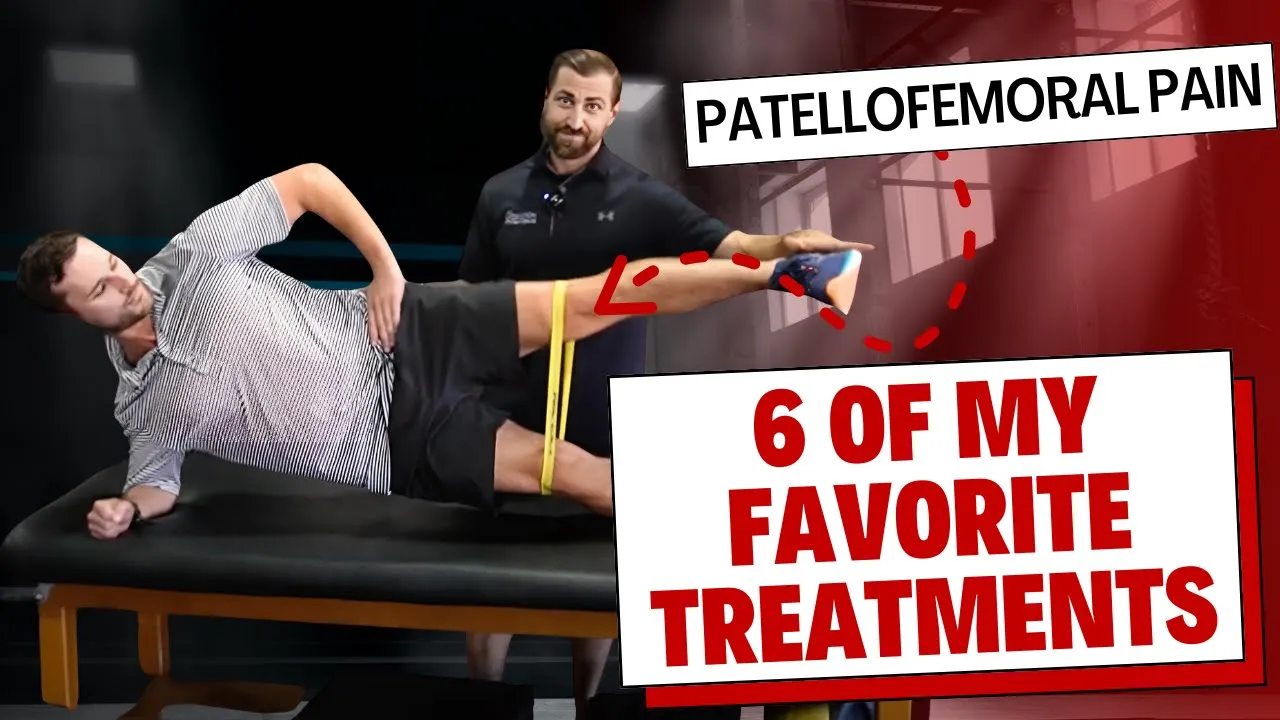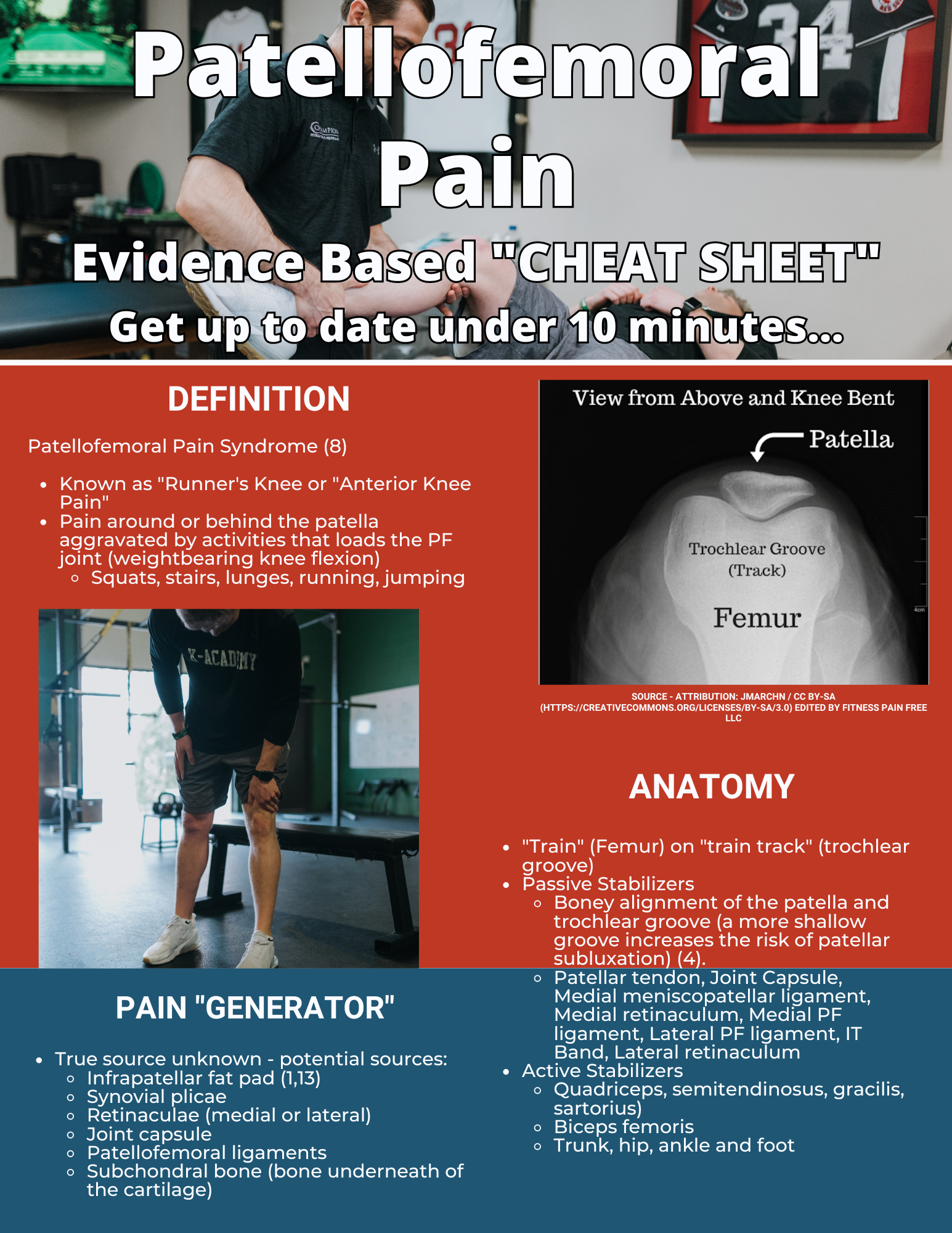
Patellofemoral Pain Clinical Examination [Physical Therapist Guide]
To go along with today's episode I have a nice infographic to share...
Sign up to receive FREE: Patellofemoral Pain - The Evidence Based Cheat Sheet
Click HERE to Download FREE
Grab the rest of the Mini Course and Sign up for the Certification Pre-sale list:
- FPF Mini Course - 7 Reasons Why Injuries Happen in the Gym and What to do About it
- The Fitness Pain Free Certification
In today's video we go over Patellofemoral Pain Clinical Examination [Physical Therapist Guide]. Learn how to differentiate it from other knee conditions, identify key red flags, and perform essential tests to guide your treatment plan.
We'll cover:
- Common patient presentation and history
- Objective findings: ROM, palpation, special tests, and movement analysis
- Differential diagnosis considerations
Time Stamps:
- 0:00 - Intro
- 0:10 - What is Patellofemoral Pain?
- 0:50 - Common Populations
- 1:07 - Where is Pain Located?
- 1:44 - What Hurts?
- 1:55 - Symptom Onset
- 3:43 - Objective Examination
- 6:18 - Palpation
- 7:32 - Provocative Movements
- 8:32 - Manual Muscle Testing (MMT)
- 10:00 - Movement Analysis
- 11:20 - Conclusion
Always capped,
- Dan Pope DPT,OCS,CSCS
Show Notes / Relevant Articles:
- FPF Mini Course - 7 Reasons Why Injuries Happen in the Gym and What to do About it
- What Physical Therapists Need to Know [Patellofemoral Pain]
- Patellofemoral Pain - Evidence Based Treatments [Physio Guide]
- My Favorite Single Leg Exercise Modifications for Knee Pain [Lunges, Step-ups, Single Leg Squats]
- Great Quad Exercises for Painful Knees
Want to support me and decide topics for future episodes? Click HERE to sign up for FPF "Insiders" for just a dollar. You'll gain access to 100+ webinars, e-books and complete guides. Plus, you'll get private access to the "Insiders" Facebook group where you can have all of your questions answered by me.
Looking for other ways to support me that are 100% free?
- Like, comment and share on youtube, facebook and instagram
- Leave a 5-star review on apple podcasts
Thank you!
Dan Pope DPT, OCS, CSCS
References:
Glaviano NR, Kew M, Hart JM, Saliba S. DEMOGRAPHIC AND EPIDEMIOLOGICAL TRENDS IN PATELLOFEMORAL PAIN. Int J Sports Phys Ther. 2015 Jun;10(3):281-90. PMID: 26075143; PMCID: PMC4458915.
Tenforde AS, Sayres LC, McCurdy ML, Collado H, Sainani KL, Fredericson M. Overuse injuries in high school runners: lifetime prevalence and prevention strategies. PM R. 2011 Feb;3(2):125-31; quiz 131. doi: 10.1016/j.pmrj.2010.09.009. PMID: 21333951.
Willy RW, Hoglund LT, Barton CJ, Bolgla LA, Scalzitti DA, Logerstedt DS, Lynch AD, Snyder-Mackler L, McDonough CM. Patellofemoral Pain. J Orthop Sports Phys Ther. 2019 Sep;49(9):CPG1-CPG95. doi: 10.2519/jospt.2019.0302. PMID: 31475628.
Lankhorst NE, van Middelkoop M, Crossley KM, Bierma-Zeinstra SM, Oei EH, Vicenzino B, Collins NJ. Factors that predict a poor outcome 5-8 years after the diagnosis of patellofemoral pain: a multicentre observational analysis. Br J Sports Med. 2016 Jul;50(14):881-6. doi: 10.1136/bjsports-2015-094664. Epub 2015 Oct 13. PMID: 26463119.
Collins NJ, Vicenzino B, van der Heijden RA, van Middelkoop M. Pain During Prolonged Sitting Is a Common Problem in Persons With Patellofemoral Pain. J Orthop Sports Phys Ther. 2016 Aug;46(8):658-63. doi: 10.2519/jospt.2016.6470. Epub 2016 Jul 3. PMID: 27374012.
Lankhorst NE, Bierma-Zeinstra SM, van Middelkoop M. Risk factors for patellofemoral pain syndrome: a systematic review. J Orthop Sports Phys Ther. 2012 Feb;42(2):81-94. doi: 10.2519/jospt.2012.3803. Epub 2011 Oct 25. PMID: 22031622.
Loudon JK. BIOMECHANICS AND PATHOMECHANICS OF THE PATELLOFEMORAL JOINT. Int J Sports Phys Ther. 2016 Dec;11(6):820-830. PMID: 27904787; PMCID: PMC5095937.
Current Concepts and Treatment of Patellofemoral Compressive Issues IJSPT 2016 https://www.ncbi.nlm.nih.gov/pubmed/27904792
2016 Patellofemoral pain consensus statement from the 4th International Patellofemoral Pain Research Retreat, Manchester. Part 1: Terminology, definitions, clinical examination, natural history, patellofemoral osteoarthritis and patient-reported outcome measures" in Br J Sports Med, volume 50 on page 839.
Blønd L, Hansen L. Patellofemoral pain syndrome in athletes: a 5.7-year retrospective follow-up study of 250 athletes. Acta Orthop Belg. 1998 Dec;64(4):393-400. PMID: 9922542.
Hoglund LT, Hulcher TA, Amabile AH. Males with patellofemoral pain have altered movements during step-down and single-leg squatting tasks compared to asymptomatic males: A cross-sectional study. Health Sci Rep. 2024 Jun 12;7(6):e2193. doi: 10.1002/hsr2.2193. PMID: 38868539; PMCID: PMC11168284.
Chamorro-Moriana G, Espuny-Ruiz F, Ridao-Fernández C, Magni E. Clinical value of questionnaires & physical tests for patellofemoral pain: Validity, reliability and predictive capacity. PLoS One. 2024 Apr 17;19(4):e0302215. doi: 10.1371/journal.pone.0302215. PMID: 38630735; PMCID: PMC11023591.
Xie P, István B, Liang M. The Relationship between Patellofemoral Pain Syndrome and Hip Biomechanics: A Systematic Review with Meta-Analysis. Healthcare (Basel). 2022 Dec 28;11(1):99. doi: 10.3390/healthcare11010099. PMID: 36611559; PMCID: PMC9818693.
Hott A, Pripp AH, Juel NG, Liavaag S, Brox JI. Self-efficacy and Emotional Distress in a Cohort With Patellofemoral Pain. Orthop J Sports Med. 2022 Mar 8;10(3):23259671221079672. doi: 10.1177/23259671221079672. PMID: 35284585; PMCID: PMC8908394.
Sanchis, G.J.B., Nascimento, J.A.S., Santana, R.C. et al. Biomechanical factors associated with patellofemoral pain in children and adolescents. Sci Rep 14, 15490 (2024). https://doi.org/10.1038/s41598-024-64394-w
Rethman KK, Mansfield CJ, Moeller J, De Oliveira Silva D, Stephens JA, Di Stasi S, Briggs MS. Kinesiophobia Is Associated With Poor Function and Modifiable Through Interventions in People With Patellofemoral Pain: A Systematic Review With Individual Participant Data Correlation Meta-Analysis. Phys Ther. 2023 Sep 1;103(9):pzad074. doi: 10.1093/ptj/pzad074. PMID: 37354454; PMCID: PMC10517194.

